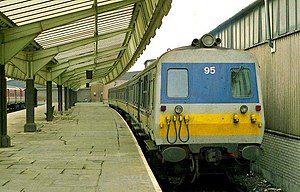NIR Class 80
| Northern Ireland Railways Class 80 | |
|---|---|

80 Class Unit 8095 York Road station in 1991.
|
|
| In service | 1974–2012 |
| Manufacturer | BREL |
| Family name | Mark 2 |
| Number built | 22 power cars, trailers see below |
| Formation | 2, 3, 4 or 6 cars per set |
| Capacity | Variable depending on trailer capacity, most 3 car sets 210 |
| Operator(s) | Northern Ireland Railways |
| Line(s) served |
Belfast-Derry Belfast-Bangor Belfast-Newry Belfast-Larne Coleraine-Portrush |
| Specifications | |
| Maximum speed | 70 mph (113 km/h) |
| Prime mover(s) | English Electric 4SRKT |
| Safety system(s) | AWS, TPWS |
| Track gauge | Irish gauge – 1,600 mm (5 ft 3 in) |
The Class 80 is a type of diesel electric multiple unit formerly used by Northern Ireland Railways. They were affectionately nicknamed 'Thumpers' by rail enthusiasts due to the thumping noise their engines produced.
By the early 1970s the MEDs and units inherited from the GNR(I) had been in service for 20 years, and the MPDs for 10 years. To replace these increasingly life-expired units, Northern Ireland Railways placed an order with BREL for 9 new DMUs. These were to be built as four 3-car and five 2-car sets and were delivered in 1974/75. Structurally, the new trains were based on the British Rail MK IIb bodyshell, which NIR was already using for the Enterprise service. The new trains were named as the Class 80.
The power cars were fitted with an English Electric 560 HP diesel engine, with electric transmission to two traction motors mounted on the rear bogie. The seating capacity of the power cars was 45, however after providing for wheelchair accommodation, this was reduced to 42. The vehicle also incorporated a guards/parcel compartment. The intermediate coaches were fitted with an additional door on each side to aid passenger flow and had a capacity of 87. The driving trailers had a small cab built at one end, which necessitated the removal of six seats. This cab was set to the left to preserve the gangway connection, so that two train sets could be coupled together and still allow passengers to travel between the trains. All three types are of integral construction, however the power cars, because of their weight, also have an underframe. They were similar to the UTA 70 Class, both mechanically and electrically.
The Class 80 was intended to replace the aging MED, MPD and ex-GNR AEC and BUT railcars on the NCC services and the suburban service between Bangor and Portadown. The railcars proved so successful that a second series was ordered in 1975, entering service in 1977/78.
...
Wikipedia
